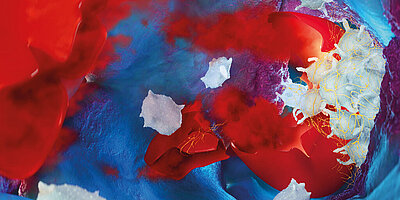Scientific Calendar January 2023
Knowledge is power – from clinical cancer research to diagnostics benefitting women’s health
Which genetic biomarker became famous in 2013 as the key decision point for Angelina Jolie to undergo a bilateral risk-reducing mastectomy?
HER2
EGFR
TP53
BRCA1
Congratulations!
That's the correct answer!
Sorry! That´s not completely correct!
Please try again
Sorry! That's not the correct answer!
Please try again
Notice
Please select at least one answer
Scientific background
Introduction
During the last years, the diagnostic and surgical approaches in oncology have become more personalised and less invasive. This is in part due to the establishment of the sentinel lymph node concept and the increased application of molecular genetic testing for cancer diagnosis and monitoring, which allows a better characterisation and understanding of the cancer, its behaviour and aggressiveness as well as the patient’s risk and prognosis, thus supporting the choice of the right treatment, as well as familial genetic counselling.
A reliable assessment of the tumour’s mutational status is decisive in selecting cancer patients eligible for targeted therapy, but also later in monitoring response to treatment and disease progression. Nowadays, a range of medications targeting tumour-specific genetic alterations are available and can be prescribed instead of, or in combination with, standard chemotherapies, immunotherapies and radiotherapies.
To investigate such genetic changes, oncologists can make use of a variety of molecular genetic tests which may support them in making personalised treatment decisions.
BRCA genes and hereditary cancer
BRCA1 and BRCA2 genes represent the predominant and most well-characterised genetic risk factors so far identified for breast, ovarian and prostate cancer. Germline mutations of the BRCA1 and BRCA2 genes lead to an increased lifetime risk of these cancers for first- and second-degree family members [1].
The Sysmex solution to help clinical researchers to investigate the overall genomic landscape of breast and ovarian cancer is the SureSeq™ Germline Breast Cancer + CNV Panel*. It has been developed to provide comprehensive coverage of seven key genes implicated in breast and ovarian cancer, including BRCA1, BRCA2, ATM, TP53, CHEK2, PALB2, PTEN, and other relevant genetic mutations using next-generation sequencing.
Tumour tissue testing with CytoCell FISH probes for HER2
HER2 amplification is seen in approximately 15% of breast cancers and, in the absence of therapy, is associated with a poor prognosis. Treatment of patients with HER2 amplification using a specific monoclonal antibody drug has been shown to be effective, increasing overall survival time [2].
With CytoCell® FISH (fluorescence in situ hybridisation) probes* for HER2 (ERBB2), FGFR1, TOP2A, MET, EGFR and RB1 genes, oncologists will get specific information on key drug-sensitive genes and prognostic markers.
Evaluation of sentinel lymph node biopsy with OSNA
When diagnosed with cancer, metastatic spread to the nearby lymph nodes is an important prognostic factor and an important criterion guiding treatment decisions. In patients with early-stage breast cancer, the sentinel lymph node biopsy (SLNB) is the standard procedure to evaluate whether axillary lymph nodes (ALN) are affected or not. Should no metastases or only very low tumour loads be found in the sentinel lymph nodes (SLN), dissection of further axillary nodes can be avoided, enabling less invasive surgical interventions. This helps to significantly reduce morbidity in these patients and the risk for unwanted side-effects such as lymphedema. Hence, accurate nodal staging is essential and requires a highly sensitive and comprehensive analysis such as is possible with OSNA (one-step nucleic acid amplification). OSNA is a rapid molecular assay which, in contrast to histopathology, allows an analysis of the entire lymph node, thereby avoiding missing even tiny metastases such as are expected particularly after neo-adjuvant systemic therapy (NAST). Furthermore, OSNA results are available already intraoperatively, allowing surgeons a fully informed decision during the surgical procedure. This allows clinicians to decide more safely about the degree of axillary surgery, and whether and what kind of adjuvant treatment might be needed.
Moreover, the quantitative OSNA result (CK19 mRNA copy number) not only provides information about the extent of the metastatic burden in SLN, but is also a valuable tool in predicting the risk of further metastatic nodes in the axilla as well as a patient’s prognosis as shown in several publications. Thus, OSNA adds value to nodal staging by providing more differentiated diagnostic information in comparison to conventional histopathology.
Recurrence monitoring via liquid biopsy with Plasma-SeqSensei
Despite surgical and/or systemic primary treatment, up to 30% of breast cancer patients face disease progression. Thus, frequent monitoring of patients for therapy response, rise of resistant mutations and tumour recurrence are of vital importance to secure the best possible long-term outcome for the patient.
At the stage of monitoring, however, tissue samples are often not available for analysis. This is where liquid biopsy can offer a valuable solution. In contrast to tissue biopsy, liquid biopsy (LB) can be carried out frequently with minimal patient distress. It has proven to overcome other limitations of tissue biopsy such as unfeasibility, missing tumour heterogeneity, limited amount of sample, and long turnaround time. In observational studies, LB has shown the potential to detect recurrence up to several months prior to conventional imaging.
Plasma-SeqSensei Breast Cancer IVD Kit offers liquid biopsy solutions based on next-generation sequencing (NGS), technology that enables highly sensitive and quantitative detection of mutations in circulating tumour DNA (ctDNA). Results are delivered within two days as easy-to-read reports using Plasma-SeqSensei IVD Software, thus offering oncologists a cutting-edge tool to advance precision oncology.
*CytoCell® FISH probes are CE IVD for laboratory professional use only. Not intended for use as stand-alone diagnostics or companion diagnostics. Therapeutic action should not be initiated on the basis of the FISH result alone. CytoSure®, SureSeq™ and CytoCell myProbes®: For Research Use Only, not for use in diagnostic procedures. Product availability may vary from country to country and is subject to varying regulatory requirements. Contact your local representatives for availability.
References
[1] Radu MR et al. (2021): Ovarian Cancer: Biomarkers and Targeted Therapy. Biomedicines. Jun 18; 9(6):693. doi: 10.3390/biomedicines9060693.
[2] Fountzilas G et al. (2013): Evaluation of the prognostic role of centromere 17 gain and HER2/topoisomerase II alpha gene status and protein expression in patients with breast cancer treated with anthracycline-containing adjuvant chemotherapy: pooled analysis of two Hellenic Cooperative Oncology Group (HeCOG) phase III trials. BMC Cancer; 13:163.






